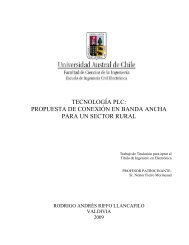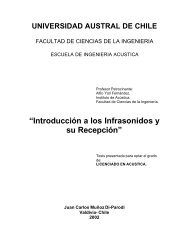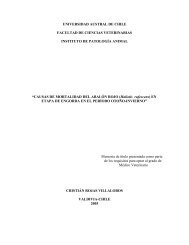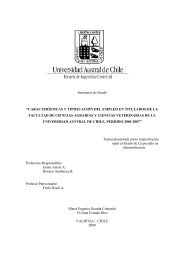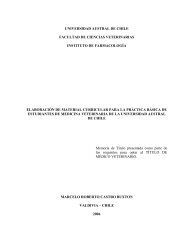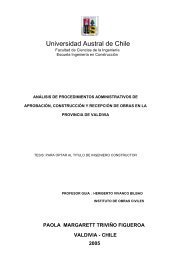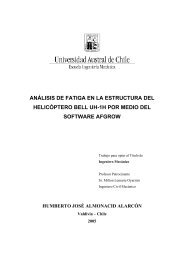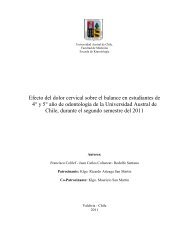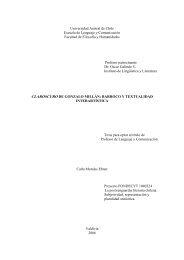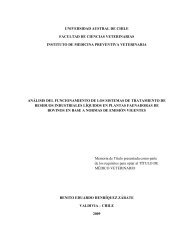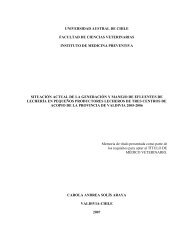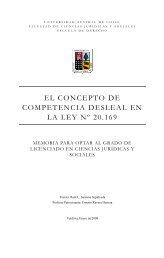Diversidad y control biológico de insectos - CyberTesis UACh ...
Diversidad y control biológico de insectos - CyberTesis UACh ...
Diversidad y control biológico de insectos - CyberTesis UACh ...
Create successful ePaper yourself
Turn your PDF publications into a flip-book with our unique Google optimized e-Paper software.
(Departamento <strong>de</strong> Producción y Sanidad Vegetal, Universidad Austral <strong>de</strong> Chile) over the<br />
last ten years. Some specimens were not i<strong>de</strong>ntified to the species level, thus the terms<br />
“taxa” and “species” are used interchangeable in this paper. Voucher specimens were hold<br />
in the Quilamapu Regional Research Centre, INIA, and the Entomology Laboratory,<br />
Universidad Austral <strong>de</strong> Chile.<br />
Data sets.<br />
Four data sets were available:<br />
Predator guild from pitfall trapping (data set I). This data set comprises two spi<strong>de</strong>r<br />
families (Lycosidae and Gnaphosidae) and 11 species of carabid beetles: Mimodromites<br />
cyanaeus (Dejean), Trechisibus angularis Jeanel, Calosoma vagans (Dejean), Metius<br />
flavipes (Dejean), Parhypates sp., Trirammatus unistriatus (Dejean,), Allendia chilensis<br />
(Dejean), Argutoridius chilensis (Dejean), Ceroglossus chilensis Eschscholtz,<br />
Ferionomorpha aerea (Dejean) and Ferionomorpha nebroi<strong>de</strong>s (Curtis).<br />
Predator guild from core sampling (data set II). This data set comprises six taxa: the<br />
spi<strong>de</strong>r families Gnaphosidae and Lycosidae, the rove beetle family Staphylinidae, the<br />
earwig Forficula sp., and the taxa Carabidae (larva) and Carabidae (adult). The carabid<br />
adults were pooled because they were present at low number. The Carabidae (larva) was<br />
treated as separated taxa because the larva were not unequivocally assigned to an species.<br />
Non-target herbivore guild (data set III). The taxa inclu<strong>de</strong>d in this data set were<br />
extracted from soil cores by the Berlese method. The eight taxa were: the ryegrass weevil<br />
Listronotus bonariensis, the diptera Tipulidae, the families Elateridae, Noctuidae,<br />
Cantharidae, Curculionidae (larva), the weevil Apion sp. and the taxa Other Coleoptera.<br />
Decomposers guild (data set IV). These specimens were extracted from soil cores as<br />
above and comprimes four taxa: earthworms (Lombricidae), larva of the Stratiomyiidae<br />
family, the Oribatidae mites and Coleoptera.<br />
Statistics and analysis of data.<br />
The experiment was arranged in a completely randomized <strong>de</strong>sign, with four replicates. The<br />
size of each plot was 30 x 30 m. Multi-variate analysis were conducted to test whether the<br />
treatment regimes affected the activity or <strong>de</strong>nsity of selected guilds.<br />
80



